I Was Taught That the Way of Progress Was Neither Swift Nor Easy Quizlet
Game show classroom: Comparing Kahoot!, Quizizz, Quizlet Live and Gimkit
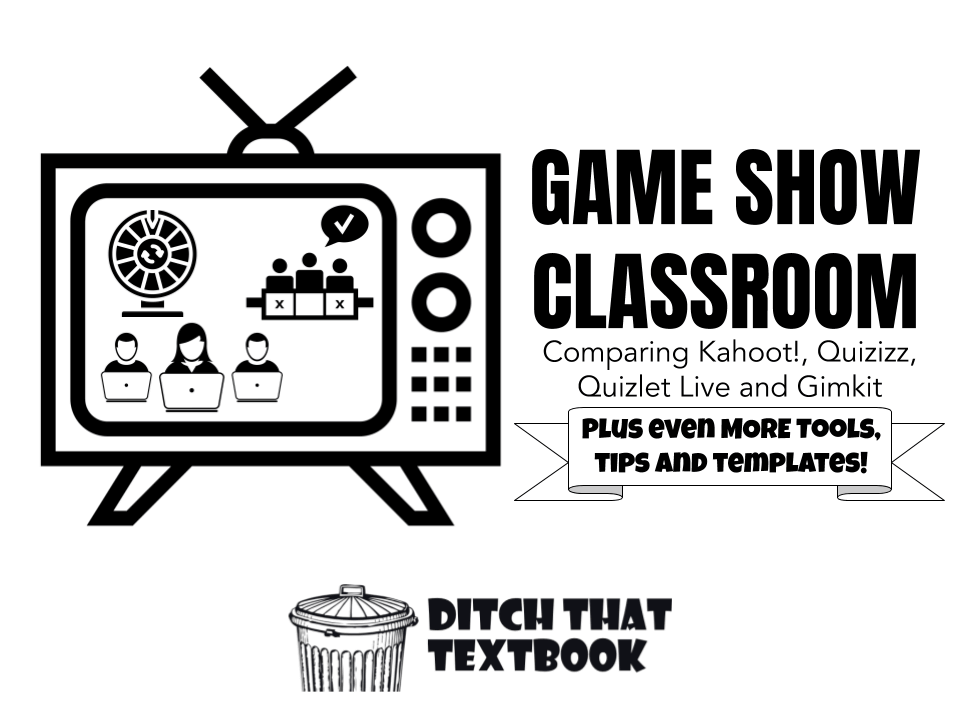


The best features of game shows can be used to review and teach in the classroom. Kahoot!, Quizizz, Quizlet Live, and Gimkit can help. See their pros, cons and what makes them different.
As a child, I remember one specific thing I always looked forward to on days when I stayed home sick from school — The Price Is Right.
Even aching, sick to my stomach or feverish as I laid on the couch, I made sure the TV was tuned to that game show around lunch time.
I loved the unique games. (Playing Plinko was a dream of mine!) I always guessed right along with the contestants during the Showcase Showdown at the end of the game. Bob Barker was the consummate host and kept things moving.
Now, teachers can bring that experience into the classroom when studentsaren't home sick.
Several digital tools created for the classroom bring those exciting experiences to students with learning as the focus.
These "game show classroom" websites do a number of things …
- Create an electric atmosphere for answering questions.
- Provide fun, interesting repetitions.
- Make in-the-moment feedback possible.
It's easier than you think to bring the fun and excitement of a game show to your classroom. Scroll down for TONS of tools, tips, templates and resource to start using in your class now!
Comparing Kahoot, Quizizz, Quizlet Live and Gimkit
We have a growing number of "gameshow classroom" options. Here are some of the ones I've found that I think are the best. Click on any of the icons below to be taken to more information about that tool.
Turn YOUR classroom into a game show!
Click on any image below to be taken directly to that section.

Kahoot! (kahoot.com)
Summary
Kahoot! is the granddaddy of the game show review games, launched in August of 2013. In a standard Kahoot! game, questions are displayed to students on a projector or display. Students respond on their own devices.
Pros
- It's a shared experience. Everyone responds at the same time. That also means we can provide feedback to everyone at the same time.
- There aremillions of publicly created Kahoot! games you can use (or duplicate for yourself and change).
- Students are likely very familiar with it, meaning it can be plugged into a lesson with little time to learn a new app.


Source: Screenshot from getkahoot.com
Cons
- The speed of a traditional Kahoot! game can make some students feel like they're left in the dust.
- It's easy for students tosee each other's responses and copy. (Just look at all of the screens the student in the foreground of the photo can see from his desk.)
Unique features
- Ghost mode. Kahoot! remembers how each student scored on each question. When you play the game again in ghost mode, it displays former attempts as "ghosts". Students can compare their current attempt to previous attempts to see how they've progressed. (If your students have played Mario Kart or another racing video game and have raced against their personal best, they're familiar with racing against a ghost.)
- The mobile app. This versatile app lets you create Kahoot! games on the fly, add pictures from your camera roll, and even host a Kahoot! game from your mobile device. Students can participate in Kahoot! challenges against classmates on their own devices.
- The friendly nickname generator. Have you ever battled naughty nicknames in a Kahoot! game? The generator will let students spin to choose from three appropriate nickname options.
Alternative ways to play
- The Blind Kahoot! game. It's a way to teach with Kahoot! instead of just reviewing. Throw students a tricky question at the beginning. Then use images, videos, class discussion and questions to teach it. It's scaffolding — teach a little, ask a question, repeat, repeat, repeat. Learn all about the Blind Kahoot! game in this blog post!

Quizizz (quizizz.com)
Summary
Quizizz takes the excitement of a gameshow-style review game and puts the whole experience in the students' hands. With a traditional Kahoot! game, everyone sees the question and possible answers on the projector and answer simultaneously. Quizizz is different because the questions and possible answers are displayed individually on student devices.
Pros
- It's student-paced. No one gets upset because their device didn't load the game fast enough to compete.
- Teachers can display a student progress dashboard on the projector to see progress of each student and instantly see how many questions the class answered right/wrong.


Source: Screenshot from Quizizz.com
Cons
- When everyone is answering different questions at different times,you lose a bit of the excitement.
- With Kahoot!, when my class answers one question all together, it isolates that piece of content so we can all talk about it. When a Quizizz game is over, you can review all the questions all at once, andyou lose that isolation.
Unique features
- Memes. These pictures with fun/funny messages are a treat. They're displayed after a question is answered to show whether it's right or wrong. Quizizz even lets you create your own (see image at right). You can use their pre-loaded images or upload your own.
- Homework mode. Students don't have to complete a game live in-person. You can use homework mode to assign it to be completed by a deadline. As someone who believes in ditching homework, I prefer homework mode to be used in rotation stations, centers and as part of choice boards instead.
- Add audio, images and math equations. When creating a new question, use the icons next to the question you're writing. The "math" button loads a keyboard of math symbols. The "media" button lets you upload audio or image.
- Power ups. Correct questions get students these powers, like immunity (second chance after incorrect answer), power play (everyone gets 50% more points for 20 seconds), and x2 (double points for one question).
Alternative ways to play
- The Fast and the Curious eduprotocol. By using Quizizz in this way, you reduce (or eliminate) your need for worksheet-based homework. Play a quick Quizizz game and look at the results. Do a quick re-teach or mini-lesson about students' struggles. Replay the game immediately. Repeat this on Monday, Tuesday, Wednesday. On Thursday, if students average a 90 percent or higher, give everyone an A and move on. Jon Corippo, co-author of The EduProtocol Field Guide, describes The Fast and the Curious eduprotocol on this episode of The 10 Minute Teacher podcast.
- Student-created Quizizz games. Students can submit questions to be asked in a Quizizz game using Google Forms survey. Import the data from the spreadsheet connected to the survey into a Quizizz game instantly and play the game. It's low-prep, student-driven review fun! See how in this tutorial video by California educator Joe Marquez. And, hear Quizizz founder Deepak Joy Cheenath describe it in this episode of the Ditch That Textbook podcast. (Note: Spreadsheet import is now an option for Kahoot! too.)

Quizlet Live (quizlet.com/live)
Summary
Quizlet's foray into the game show-style review is the best collaborative game. Instead of students answering individual questions on their individual devices, Quizlet puts students in groups. All possible answers are divided amongst the devices of all students participating. Think of three students with 12 possible answers … they're divided up with four on each devices, so the answer may or may not be on your device. Teams race to get all answers correct in a row to win.
Need to know how to set up and run a Quizlet Live game? How to start a Quizlet Live game in 60 seconds + tips and tricks
Pros
- Teamwork and communication. With traditional flashcards, students may study them in isolation quietly. This brings students together in a game where they must depend on each other.
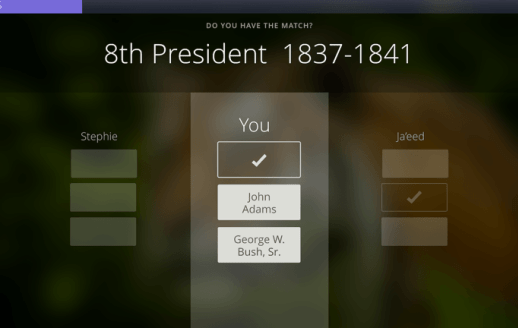
Source: Screenshot from Quizlet.com
- Play games with Quizlet flashcard sets.Quizlet Live runs from Quizlet flashcard sets. That means you don't have to create anything new if you use Quizlet and already have flashcards OR if you can find a Quizlet flashcard set you like.
- A new game every time. Each new Quizlet Live game is different. When a game pulls a dozen cards from a Quizlet flashcard set, there are tons of combinations — especially when there are LOTS of flashcards. Start a new game and Quizlet mixes up the cards for a new combination.
Cons
- You needat least six students to play a game (at least two teams of three students) and at least six cards in a flashcard set.
- If you're looking for somethingmore individual to play as a group, Quizlet Live may not be your game.
Unique features
- True team play. This is the best collaborative experience of the "gameshow classroom" options. One student can dominate in a team game on Kahoot! or Quizizz. When each student has only a handful of correct responses, everyone has more opportunity to participate.
- Built-in movement. Students are put into small groups and are encouraged to move next to their partners. This mixes up their environment and encourages physical movement, which boosts cognitive function.
Alternative ways to play
- Quizlet Quarterback. This game further ensures that one dominant student doesn't hijack the game. In a group of three, set all three student devices next to each other on desks. Two students sit and one student stands behind them. When a question appears, the standing student reads it and finds the answer. He/she taps the shoulder of the student closest to the question and that student answers the question on the screen. This is one of several alternative Quizlet Live games suggested by New York educator Patrick McMillan in this post.
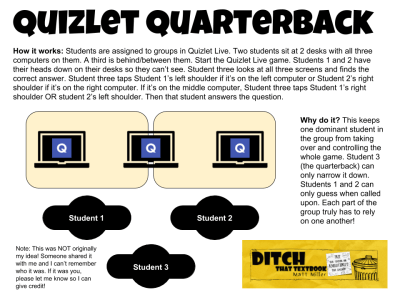
Click for full-size image (with more legible text!).
Relay. In this game, line up all student devices in a row. Students take turns answering questions. This is another alternative Quizlet Live game suggested by New York educator Patrick McMillan in this post.


Gimkit (gimkit.com)
Summary
Gimkit (gimkit.com) is like Quizizz with power-ups. In Quizizz, students collect points cumulatively throughout the game. In Gimkit, students use their points to buy power-ups in the store. Power-ups let students earn more points per question, get additional points when they hit a streak, and even lose less points when incorrect.
"We don't do tests." Learn how teacher Omoyemwen Ngei uses Gimkit to create assessments her students love.
Pros
- New game mechanics. The upgrades put a new spin on reviewing. They're used to buying upgrades in games. Now they can add that new dynamic to digital review games.
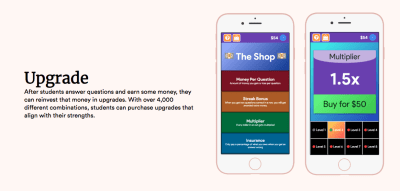
Source: Gimkit (gimkit.com) screenshot.
- Its backstory. Gimkit was created by students in Seattle, Washington, and it's still maintained by them. They made the game they wanted to play and then shared it with the world.
- Quizlet integration. You can import a Quizlet flashcard set into a Gimkit game if you have the paid version of Gimkit.
Cons
- Pricing structure. You only get to create five games with the free plan … and you have a finite amount of modifications you can make to them. Then it's $59.88 per year or the $7.99 monthly plan. A robust free version is an essential piece of many edtech tools, and Gimkit's free version is lacking … not enough to hook a teacher and help him/her realize he/she needs the full paid version.
- Limited searchable gallery. With the above options, you can tap into thousands (or millions) of teacher-created games. Unless you have the paid version and import Quizlet sets, the gallery is really lacking.
Unique features
- Purchase upgrades. Students can spend points from correct answers in the store to buy upgrades to earn points faster. They include insurance (less points for a wrong answer) and money per question (more points per right answer).
- Live view with class progress. The screen projected to the class as students answer questions is unique. It shows how everyone's points as a class add up together. This encourages class vs. class competition.
- KitCollab. This feature lets students create a Gimkit game together. Each student suggests a question. The teacher approves questions to be used in the game.
Enroll in the Game Show Classroom online course!

What you'll get...
🛠 Tools to make review and practice more like a game
💡 Ideas for turning the classroom into a game
🎨 Design tips
🧩 Inspiration to build your own games
10 more games like Kahoot!
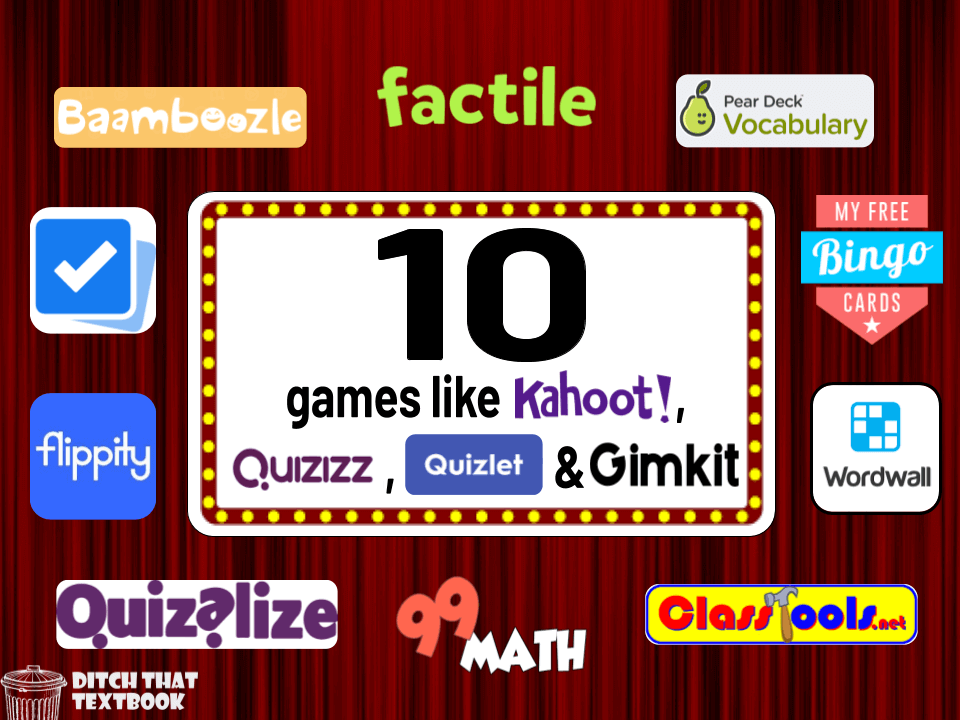
Click here for a clickable PDF version.
1. 99math
Like Kahoot! for math. 99math is a free tool that turns math into a social gaming experience. The content is already generated, teachers just have to choose the topic they want to practice and no time is spent on preparation. Setting up the game and playing with students takes only 5 minutes from the lesson! Learn more about 99math in this post by Karly Moura.

2. Baamboozle
Baamboozle is a fun game to play with your class as a bell ringer, check in, or review lesson. Play from a single device on a projector, smart board or in an online lesson. No student accounts are needed. It's simple to set up. The free version of Baamboozle allows you to make your own games to play with your class. The paid version ($7.99/month) gives you access to the premium features including a library of over 150 pre-created games.

3. Factile
Factile lets you create or play jeopardy-style quiz games for your classroom. The free version allows you to create up to 3 games and play any of the pre-created games. The Pro version ($5/month) gives you access to premium features like adding images, videos and equations plus the ability to create unlimited games.

4. Quizalize
Quizalize is another quiz-based website. Teachers can create quizzes with multiple- or two-choice question sets or single-word responses. The free version allows you to assign quizzes with follow-up resources and see results for up to 3 classes and 5 activities. The premium version ($5.75/month) gives you access to the features like unlimited classes and activities.

5. Wordwall
With Wordwall you can make custom activities like quizzes, match ups, word games and more for your classroom. Wordwall activities can also be printed out directly or downloaded as a PDF file. The printables can be used along with the interactive or as stand-alone activities. With the free version you can create up to 5 activities. Standard and Pro accounts start at $6/month.

6. Pear Deck Flashcard Factory
Flashcard Factory by Pear Deck, is a neat FREE tool to let students "crowdsource" the flashcards they'll use to study.
Check out this tutorial video, which walks you through the steps …
- Create the list of terms
- Invite students to collaborate
- Collect student images and example sentences
- Vote for the best ones
- Create a Quizlet flashcard set with what students createdAdd the flashcard set to Google Classroom




10. Plickers
This free app has been around for awhile and is still a fantastic option for quick polling in the classroom. With Plickers only the teacher needs to have a device because students hold up a paper card to show their answer.



Get the book on this subject!
Tech Like a PIRATE shares seven key ways to make learning with tech UNFORGETTABLE! You'll get practical ideas, downloadable templates, step-by-step tutorials and more. Your students will be engaged and begging for more!
![]()
8 Google Slides game show templates

1. Who Wants to be a Millionaire
Test your knowledge with this template based on the famous TV quiz show, give the correct answers, and win!

2. Frazzle
This game which is similar to "Heads Up" requires the teacher to only give the category and the students then have to get their teammates to guess them by providing clues. Created by Ryan O'Donnell. You can find even MORE game templates from Ryan in his listicle 10 Classroom Games.

3. Jeopardy Template
This Jeopardy! interactive template by Slides Carnival will help you create a custom game for your classroom based on the popular trivia game show.


5. The Price Is Right
In a gamified classroom old classics like "The Price Is Right" can make a comeback in the using G Suite tools! This game template, created by Jen Walter, has all students shouting "Come on down!".

6. Do You Remember?
This template, created by Matt Meyer, is based on the old children's game "Memory". You can use it to create review games across any content areas. Also check out this Memory game created by Mandi Tolen.
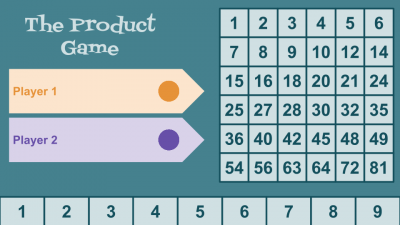

8. A game board template for anything!
Make your own game, or better yet have your STUDENTS make their own game and play it as a class! You can use this template from Slides Mania to turn any topic into your very own class game.
![]()
14 ways to turn your classroom into a game show
The music, the lights, the energy, the excitement of winning and the agony of defeat. Gameshows are engaging and fun. It's no wonder that our students love to be a part of game show style learning in our classrooms.
So how can we help students feel the thrill of winning? Or the agony of defeat? And what apps or tools are already out there to help turn your classroom into your very own "game show"?
During a weekly #DitchBook Twitter chat, educators tackled these questions and more. They shared links to resources, examples, ideas for putting a creative spin on familiar games!

1. Play the part! Bring the music and your best game show host voice to really get the class involved.
A3: The host of the game show is what really makes a show.We can all name a game show we don't like and usually it has to do with the host.Make sure you're invested, over the top and excited to be hosting the game in your classroom and the Ss will pick up on your vibe. #ditchbook
— Nicole Nowlin (@nicole_nowlin) October 25, 2019

2. Add Family Feud style fun to your class or PD with a survey from your own community of learners. Use this Family Feud game template to get started.
A2 - I did a PD where we played family feud and teachers tried to guess the top 100 answers from their students... #ditchbook
— Sarah Warren (@wizardwarren) October 25, 2019

3. Quizizz is a fun, way to engage students in review and assessment at school or at home. And best of all, it's free. Pair it with the Fast and Curious EduProtocol and you can really level up the fun!


5. Flippity.net allows you to turn a Google Spreadsheet into a game. Try the scavenger hunt, BINGO, matching games and more!

6. An arcade game generator, Fakebook profile, random name picker, image reveal. Those are just a few of the fantastic tools available for FREE on classtools.net.

A2: I💖using Powerpoint for Jeopardy. Animations, Linked slides, dim lights, the Jeopardy theme song, I go all out. All Ss write Qs on 1 side of a white board paddle & keep track of $ totals on the other side. The Ss love the think theme 𝅘𝅥𝅮 during final Jeopardy. #ditchbook
— Vicki (@33heupel) October 25, 2019

8.Wheel decide is a fun way to bring a little game show fun even if you only have a few minutes. You can add your own choices in or check out their premade wheels for a quick time-filler.

9. Gimkit is quickly becoming a favorite among teachers and students. It's like Quizlet but with power-ups. Gimkit has tons of engaging themes too like Thanos mode or zombies vs. humans. Check out our post Game show classroom: Comparing Kahoot!, Quizizz, Quizlet Live, and Gimkit to learn more.

10 . Head Bands with index cards is the perfect, tech-free, game show style option for vocabulary review.

A4: I have used a "Who Wants to Be a Millionaire" template and inserted my own questions. Every time I would ask a question, we turned the lights off and played the dramatic music 😊 #Ditchbook
— Megan Maxwell Naglik (@MeganNaglik) October 25, 2019

12. The chance that ANY of audience members could be called to play makes The Price Is Right even more exciting to watch. Check out this Price is Right Estimation game created by Jen Walter that turns math into a game show by asking students to "come on down!"


14. Kahoot! is always a student favorite. The music alone turns up the engagement level (and the noise level) in any classroom. There are lots of different variations for playing. Try a blind Kahoot!, ghost mode, team play, or even a connected Kahoot!
A3: I think the feeling of success can be felt by any student. Especially if you play multiple rounds. @GetKahoot has Ghost Mode, so you can play against yourself to track improvement. Let all Ss feel the thrill of victory! #ditchbook https://t.co/0XsiXsXMtM
— Evan Mosier (@emosier3) October 25, 2019
These aren't the only options for reviewing in this way. If you use others, we'd love to see them in a comment below along with why you think they're great.
Question: Which tools have you used, and what was your experience? What other similar tools have you used? Leave a comment below.
Are you looking for quality, meaningful professional learning that both equips and inspires teachers?

Matt provides in-person and virtual keynotes, workshops and breakout sessions that equip, inspire and encourage teachers to create change in their classrooms. Teachers leave with loads of resources. They participate. They laugh. They see tech use and teaching in a new light. Click the link below to contact us and learn how you can bring Matt to your school or district!

despeissislatchaving.blogspot.com
Source: https://ditchthattextbook.com/game-show-classroom-comparing-kahoot-quizizz-quizlet-live-and-quizalize/
0 Response to "I Was Taught That the Way of Progress Was Neither Swift Nor Easy Quizlet"
Post a Comment